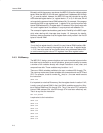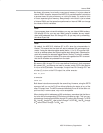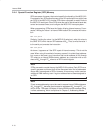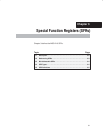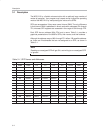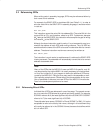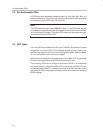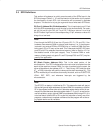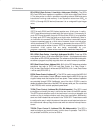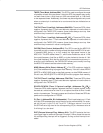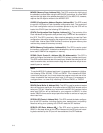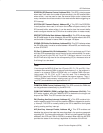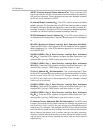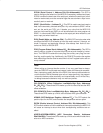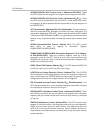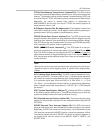
SFR Definitions
3-6
DPL0/DPH0 (Data Pointer 0 Low/High, Addresses 82
H
/83
H
): The SFRs
DPL0 and DPH0 work together to represent a 16-bit value called Data Pointer
0. The data pointer is used in operations regarding external RAM and some
instructions involving code memory. It can represent values from 0000
H
to
FFFF
H
(0 through 65,535 decimal) because it is an unsigned 2-byte integer
value,
Note:
DPTR is really DPH0 and DPL0 taken together as a 16-bit value. In reality,
DPTR must almost always be dealt with one byte at a time. For example, to
push DPTR onto the stack, first push DPL0 and then DPH0. It is not possible
to simply push DPTR onto the stack as a single value. Additionally, there is
an instruction to increment DPTR. When this instruction is executed, the two
bytes are operated upon as a 16-bit value. However, there is no instruction
which decrements DPTR. If it is necessary to decrement the value of DPTR,
special code must be written to do so. DPTR is a useful storage location for
occasional 16-bit values that are being manipulated by your
program—especially if those values need to be incremented frequently.
DPL1/DPH1 (Data Pointer 1 Low/High, Addresses 84
H
/85
H
): These two SFRs
work together to form a 16-bit value called Data Pointer 1. Its purpose and function
is the same as DPL0/DPH0 just described. The existence of two distinct data point-
ers allows a program to quickly copy data from one area of memory to another.
DPS (Data Pointer Select, Address 86
H
): Bit 0 of this SFR determines whether
instructions that refer to DPTR will use Data Pointer 0 or Data Pointer 1.
If bit 0 is clear, Data Pointer 0 will be used (DPH0/DPL0). If bit 1 is set, Data Pointer
1 will be used (DPH1/DPL1).
PCON (Power Control, Address 87
H
): This SFR is used to control the MSC1210
CPU power control modes. Certain operation modes allow the MSC1210 to go into
a type of sleep mode that requires much less power. These modes of operation
are controlled through PCON. Additionally, one of the bits in PCON is used to
double the effective baud rate of the MSC1210 primary serial port. Do not confuse
it with PDCON, which controls peripheral power-down.
TCON (Timer Control, Address 88
H
, Bit-Addressable): This SFR is used
to configure and modify the way in which the two timers of the 8052 operate.
This SFR controls whether each of the two timers is running or stopped, and
contains a flag to indicate whether each timer has overflowed. Additionally,
some non-timer related bits are located in the TCON SFR. These bits are used
to configure the way in which the external interrupts are activated and also con-
tain the external interrupt flags that are set when an external interrupt has oc-
curred.
T2CON (Timer Control 2, Address C8
H
, Bit-Addressable): This SFR is
used to configure and control the way in which timer 2 operates. This SFR is
only available on 8052s, and not on 8051s.



